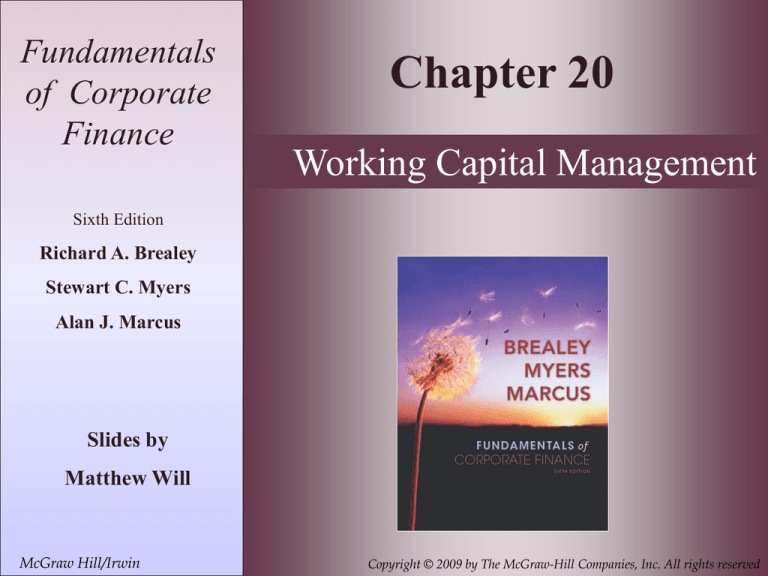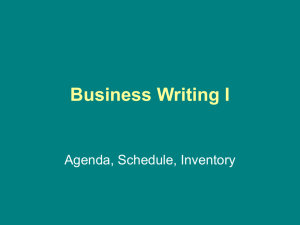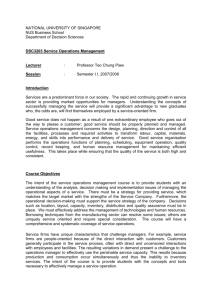
20- 1
Fundamentals
of Corporate
Finance
Chapter 20
Working Capital Management
Sixth Edition
Richard A. Brealey
Stewart C. Myers
Alan J. Marcus
Slides by
Matthew Will
McGraw
McGraw Hill/Irwin
Hill/Irwin
Copyright ©Copyright
2009 by The
McGraw-Hill
Companies, Inc.
All rights
reserved
© 2009
by The McGraw-Hill
Companies,
Inc.
All rights reserved
20- 2
Topics Covered
Accounts Receivable and Credit Policy
Inventory Management
Cash Management
Investing Idle Cash: The Money Market
20- 3
A/R and Credit Policy
Credit Management Steps
Establish terms of sale
What form of IOU will you require?
Perform a credit analysis
Create a credit policy
Develop a collection policy
20- 4
A/R and Credit Policy
Trade Credit
Bills awaiting payment from one company to
another.
Consumer Credit
Bills awaiting payment from final customer to a
company.
Terms of Sale
Credit, discount, and payment terms offered on a
sale.
20- 5
Terms of Sale
Example - 5/10 net 30
5 - percent discount for early payment
10 - number of days that the discount is available
net 30 - number of days before payment is due
20- 6
Terms of Sale
A firm that buys on credit is in effect borrowing
from its supplier. It saves cash today but will have
to pay later. This, of course, is an implicit loan from
the supplier.
We can calculate the implicit cost of this loan
Effective annual rate
(
= 1 +
)
discount
discounted price
365 / extra days credit
- 1
20- 7
Terms of Sale
Example - On a $100 sale, with terms 5/10 net 60,
what is the implied interest rate on the credit given?
Effective annual rate
1+
365/extra days credit
discount
discounted price
1 +
5 365/50
95
-1
- 1 = .454, or 45.4%
20- 8
Credit Agreements
Terminology
open account
promissory note
commercial draft
sight draft
time draft
trade acceptance
banker’s acceptance
20- 9
Credit Analysis
Open Account - Agreement whereby sales are made
with no formal debt contract.
Credit Analysis - Procedure to determine the
likelihood a customer will pay its bills.
Credit agencies, such as Dun & Bradstreet provide
reports on the credit worthiness of a potential
customer.
Financial ratios can be calculated to help determine a
customer’s ability to pay its bills.
20- 10
Credit Analysis
Numerical Credit Scoring categories
The customer’s character
The customer’s capacity to pay
The customer’s capital
The collateral provided by the customer
The condition of the customer’s business
20- 11
Credit Analysis
Multiple Discriminant Analysis - A technique used
to develop a measurement of solvency, sometimes
called a Z Score. Edward Altman developed a Z
Score formula that was able to identify bankrupt
firms approximately 95% of the time.
Altman Z Score formula
Z = 3.3
EBIT
sales
market value of equity
+ 1.0
+.6
total assets
total assets
total book debt
retained earnings
working capital
+ 1.4
+ 1.2
total assets
total assets
20- 12
Credit Analysis
Example - If the Altman Z score cut off for a credit
worthy business is 2.7 or higher, would we accept
the following client?
EBIT
.12
total assets
retained earnings
=.4
total assets
sales
1.4
total assets
working capital
=.12
total assets
market equity
.9
book debt
20- 13
Credit Analysis
Example - If the Altman Z score cut off for a credit
worthy business is 2.7 or higher, would we accept
the following client?
Firm' s Z Score
(3.3x.12) + (.
1 0x1.4) + (.6x.9) + (.
1 4 x.4) + (.
1 2 x.12) = 3.04
A score above 2.7 indicates good credit.
20- 14
Credit Analysis
Credit analysis is only worth while if the
expected savings exceed the cost.
Don’t undertake a full credit analysis unless the
order is big enough to justify it.
Undertake a full credit analysis for the doubtful
orders only.
20- 15
Return on Assets (%)
Credit Analysis
10
5
0
Failing Firms
-5
Non-failinf Firms
-10
-15
-20
4
3
2
1
Years Before Bankruptcy
20- 16
Total Liabilities as a Percentage of Assets
Credit Analysis
100
90
80
70
60
Failing firms
50
Non-failing firms
40
30
20
10
0
4
3
2
Years Before Bankruptcy
1
20- 17
EBITDA as a Percentage of Total Liabilities
Credit Analysis
40
35
30
25
20
Failing Firms
15
Non-failinf Firms
10
5
0
-5
-10
4
3
2
Years Before Bankruptcy
1
20- 18
The Credit Decision
Credit Policy - Standards set to determine the amount
and nature of credit to extend to customers.
Credit Scoring – What your lender won’t tell tell you.
Extending credit gives you the probability of making
a profit, not the guarantee. There is still a chance of
default.
Denying credit guarantees neither profit or loss.
20- 19
The Credit Decision
The credit decision and its probable payoffs
Customer pays = p
Payoff = Rev - Cost
Offer credit
Customer defaults = 1-p
Refuse credit
Payoff = 0
Payoff = - Cost
20- 20
The Credit Decision
Based on the probability of payoffs, the expected profit can be
expressed as:
p x PV(Rev - Cost) - (1 - p) x (PV(cost)
The break even probability of collection is:
PV(Cost)
p =
PV(Rev)
20- 21
The Credit Decision
Things to Remember in the Credit Decision
1.
2.
3.
Maximize profit
Concentrate on the dangerous accounts
Look beyond the immediate order
20- 22
Collection Policy
Collection Policy - Procedures to collect and monitor
receivables.
Aging Schedule - Classification of accounts receivable
by time outstanding.
20- 23
Collection Policy
Sample aging schedule for accounts receivable
Customer' s Less than
More than
1 - 2 months 2 - 3 months
Total Owed
Name
1 month
3 months
A
10,000
0
0
0
10,000
B
8,000
3,000
0
0
11,000
*
*
*
*
*
*
*
*
*
*
*
*
*
*
*
*
*
*
Z
5,000
4,000
6,000
15,000
30,000
Total $200,000
$40,000
$15,000
$43,000
$298,000
20- 24
Inventory Management
Components of Inventory
Raw materials
Work in process
Finished goods
Goal = Minimize amount of cash tied up in inventory
Tools used to minimize inventory
Just-in-time
Lean manufacturing
20- 25
Inventories
As the firm increases its order size, the
number of orders falls and therefore the order
costs decline. However, an increase in order
size also increases the average amount in
inventory, so that the carrying cost of
inventory rises. The trick is to strike a
balance between these two costs.
20- 26
Inventory, thousands of units
Managing Inventories
Inventory
60
Average
Inventory
30
0
3
6
Weeks
9
12
20- 27
Inventories
Determination of optimal order size
Inventory costs, dollars
Total costs
Carrying costs
Total order costs
Optimal
order size
Order size
20- 28
Inventories
Economic Order Quantity - Order size that
minimizes total inventory costs.
Economic Order Size Q =
2 x sales x cost per order
carrying cost
20- 29
Cash
Cash does not pay interest
Move money from cash accounts into short
term securities
“Sweep programs”
MMDAs
Concentration banking
Lock-box system
20- 30
Cash
How purchases are paid. Percentage of total by payment type for 2005.
100%
Direct debits
Credit transfers
Credit/debit cards
Checks
80%
60%
40%
20%
USA
UK
Switzerland
Sweden
Netherlands
Italy
Germany
France
Canada
0%
20- 31
Cash
Electronic Funds Transfer (EFT)
Automated Clearinghouse (ACH)
Fedwire
CHIPS (Clearing House Interbank Payments
System)
2005 CHIPS / Fedwire transaction volume = $1,000
trillion
International cash management
Compensating balances
20- 32
Float
Time exists between the moment a check is written
and the moment the funds are deposited in the
recipient’s account.
This time spread is called Float.
Payment Float - Checks written by a company that
have not yet cleared.
Availability Float - Checks already deposited that
have not yet cleared.
20- 33
Concentration Banking
Concentration Banking
System whereby customers make payments to a regional
collection center, which then transfers funds to a principal
bank.
Lock-box System
System whereby customers send payments to a post office
box, and a local bank collects and processes checks.
20- 34
Concentration Banking
Lock-box example
A lock box receives 150 payments per day, with an
average size of $1,200. The daily interest rate if .02% and
the lock box saves 1.2 days in mailing time and .8 days in
processing time.
20- 35
Concentration Banking
Lock-box example
A lock box receives 150 payments per day, with an
average size of $1,200. The daily interest rate if .02% and
the lock box saves 1.2 days in mailing time and .8 days in
processing time.
Reduced collection float
150 $1,200 (1.2 .8) $360,000
Perpetuity value of extra float earnings
$360,000 per day .0002 $72/day
($72/day) 365days $26,280
$26,280
$360,000
.073
20- 36
Managing Float
Payers attempt to create delays in the check
clearing process.
Recipients attempt to remove delays in the
check clearing process.
Sources of delay
Time it takes to mail check
Time for recipient to process check
Time for bank to clear check
20- 37
Managing Float
Availability
float
Payment
float
Check mailed
Mail float
Check received
Processing float
Check
clears
Cash available
to recipient
Check deposited
Check
clears
Check charged to
payer’s account
20- 38
Cash Balances
Money Market - market for short term
financial assets.
Treasury bills
commercial paper
certificates of deposit
repurchase agreements
LIBOR
20- 39
Web Resources





